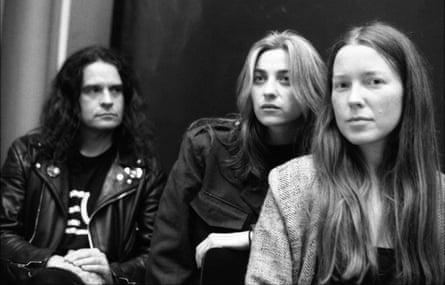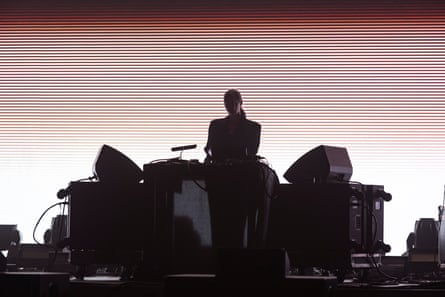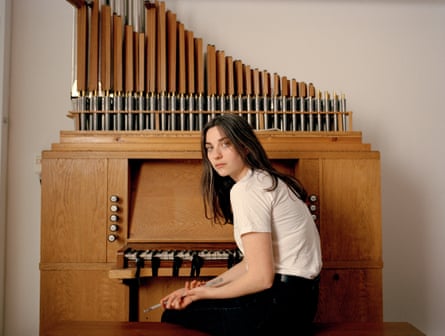Listening to composer Kali Malone’s Does Spring Hide Its Joy is like watching weather move across a landscape. Sinewaves and strings swell gently, like a calm dawn; electric guitar overwhelms like clouds blocking the sun. It is the US composer’s fifth full-length album and her most expansive. It contains three hour-long versions of the piece, which has been performed with visuals that bathe the audience with pulsating bands of colour. “I want to create an immersive environment so that when it’s over, you don’t know how much time has passed,” Malone explains to me in the empty Purcell Room on London’s South Bank, the afternoon before a second performance.
The tenacious, smart Malone is still in her 20s but already has a large fanbase for her minimalist pieces. She writes for choir, electronics and other instruments, but after numerous split releases and EPs, her following snowballed in 2019 behind the organ dirges of The Sacrificial Code. It has become her signature instrument, one she regularly plays in famed churches and cathedrals – recently in Gaudí’s Sagrada Família in Barcelona. But, she says emphatically: “I’m not an organist, I’m a composer.” And last year’s acclaimed Living Torch cemented her in a lineage of minimalists and electroacousticians, made on French artist Éliane Radigue’s rare ARP 2500 synthesiser: density builds through a melodic cycle; pitches cluster, roaring, occasionally breaking free to soar skyward. It has a glorious goth residue, resisting the feel of squeaky clean concert-hall classical.
Moving away from organs, Does Spring Hide Its Joy is her best album yet: a collaboration on which Malone plays tuned sinewave oscillators, with Lucy Railton on cello and Stephen O’Malley of Sunn O))) on guitar. The time-stretching, tuning-based piece illuminates what it is to surrender to sound as it masses around you. “I didn’t want landmarks that anchor your memory of the music,” she says. “I want it to be this indescribable feeling.”
This applies as much to audiences as the players, who have to listen acutely to one another when performing. Where a previous generation of composers in this lane such as Radigue or Catherine Christer Hennix often worked within a spiritual practice, Does Spring Hide Its Joy finds Malone working from a natural sublime, rooted in the awe of the Colorado mountain ranges where she is from. “Those mountains have defined every era of my life since I was a child,” she says.

Malone grew up mostly in Denver, where she sang in state choirs, studied classical vocal music, then discovered gigs age 13. “I was a very independent kid, with not so much supervision, and very adventurous,” she says. She moved to Massachusetts alone to study music, then boldly to Stockholm, aged 18, after becoming friends with Swedish avant-garde composer Ellen Arkbro. “I just knew I needed to go,” she says, “I was naive enough to arrive with just an amplifier and my guitar, but the first week I got a job, got my visa, an apartment – I somehow figured it all out.”
She studied electroacoustic composition at Stockholm’s Royal College of Music, where she found a fertile cohort including Arkbro, synth musician Caterina Barbieri and Maria W Horn (with whom she ran the label XKatedral) among others. Stockholm provided access to rare synths at EMS, and she began working as a technician at experimental venue Fylkingen (to sound poetry what New York’s CBGB was to punk). During this intense creative time, she made much of what became 2018’s Organ Dirges 2016-17 and Cast of Mind, and The Sacrificial Code: “I would roll all the microphones and mic stands across the building where the organ was every day,” she says. “I was the last one to leave school every night – I’d often get locked in.”
Malone’s organ fixation started when she interviewed organ tuner Jan Börjeson while studying. She began apprenticing with him, climbing inside the bellies of these mechanical whales. She was fascinated by their clacking, wheezing physicality, but also by the possibilities of tunings. “Holding down two notes, the beating patterns that then occur reminded me of what I was searching for in my electronic music,” she says.

She becomes visibly excited explaining the technicalities of how historical organs have been retuned through a process of harmonic standardisation. Grappling with terminology, I ask if this means some are essentially wearing clothes that don’t fit? “That’s a good way to put it,” she says, kindly. She elaborates about wolf tones and commas, and I am utterly lost. “I don’t understand why more people don’t know about harmonics,” she says. “We learn about chemistry, about colour – the science of sound doesn’t just apply to musicians – we experience sound every moment of our lives.”
She mentions a less sublime environmental sound. “There’s a leaf-blower that wakes me up every morning,” she says. “I remember once sprinting outside with my recorder because five guys were leaf-blowing together – it was one of the best sounds I’ve ever heard.” This is the mindset of a musician who is as much receiver as composer: “There’s so much beautiful sound out there – it’s all just your perception whether you experience it as music.”

